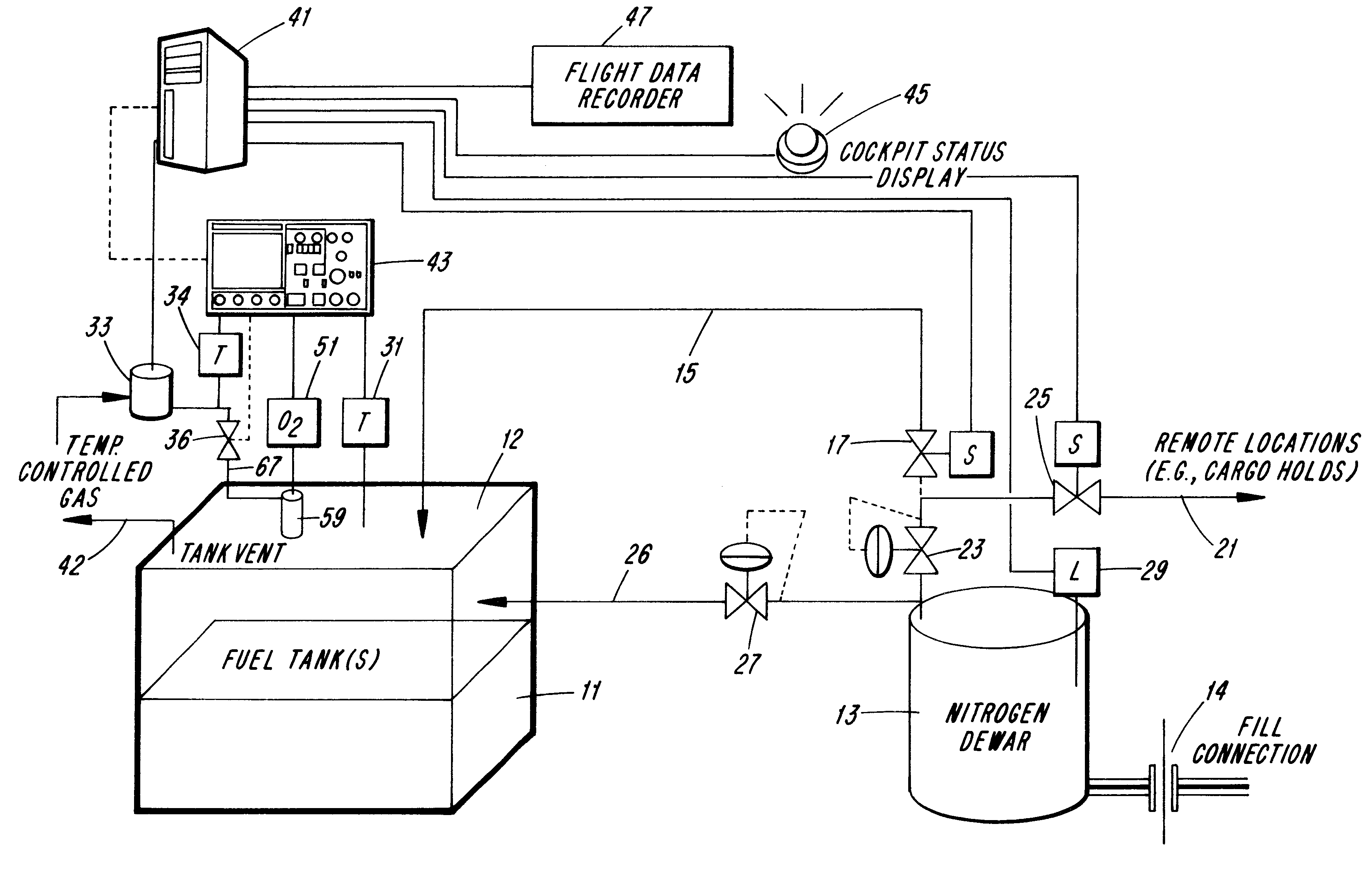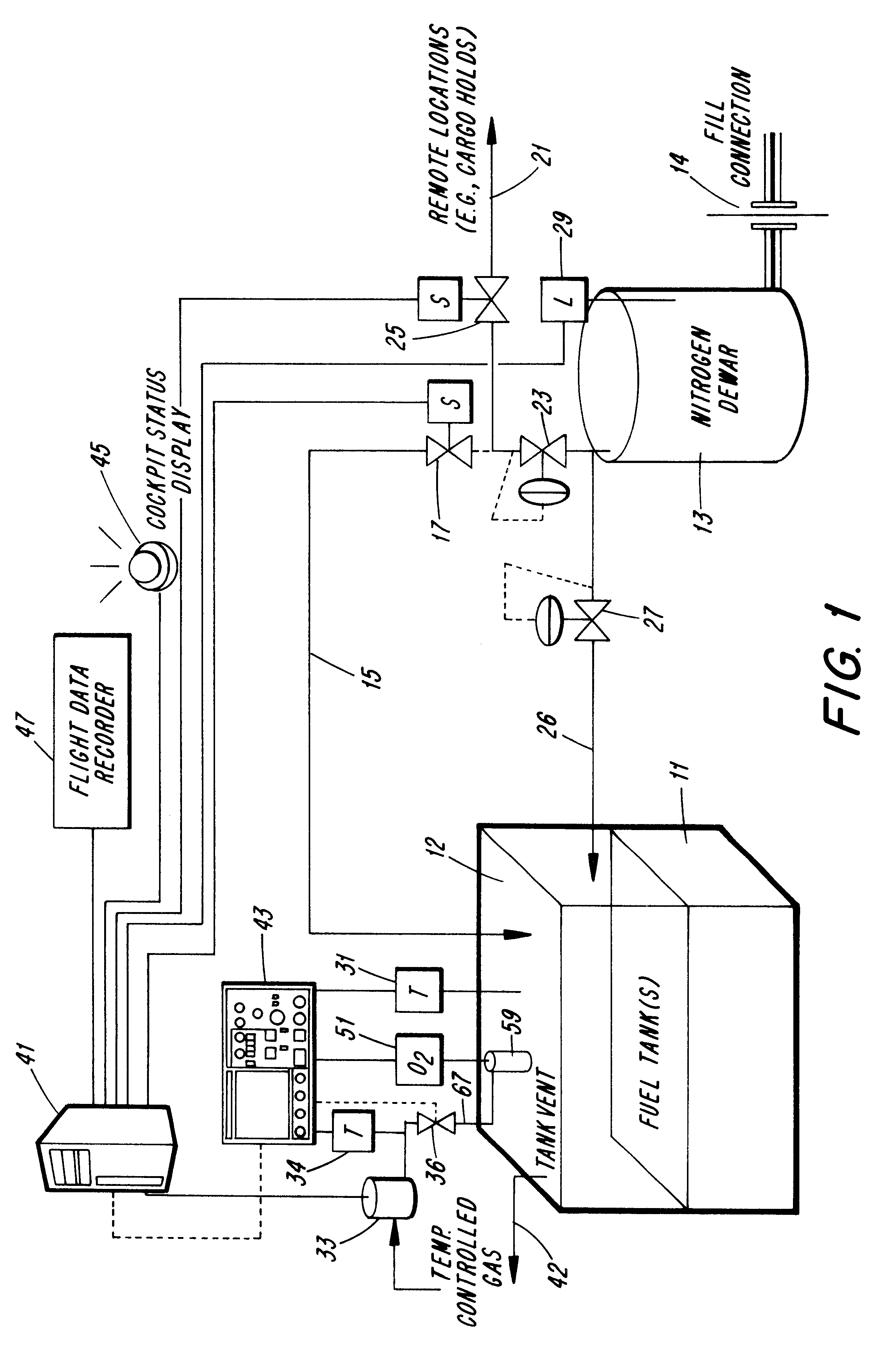In particular, the instant invention provides a
system that provides an inert
blanket of a
nitrogen rich gas
atmosphere to a fuel tank or other environment so as to inert that environment from the prospect of explosion. In a further aspect of this invention there is provided a
system with safe and effective monitoring of the oxygen concentration (preferably measured as oxygen
partial pressure) in the
atmosphere in a tank or other area to be inerted such that nitrogen can be metered efficiently from a
liquid nitrogen source to maintain the
atmosphere at a desirably
low oxygen concentration so that the potential of explosion is minimized or eliminated. Temperature of the tank can also be monitored further to assess the potentially explosive character of the tank contents. There is further provided an effective probe which can effectively monitor the
oxygen content of the atmosphere within a fuel tank, and which can accomplish that monitoring function accurately without introducing a danger that the probe itself can be a source of sparking that could initiate an explosion. In a special embodiment, the probe is a passive
fiber optic probe that can be extended into the fuel tank or other environment to monitor
oxygen content and provide a basis for controlling oxygen concentration. Because, in the particular embodiment of this invention, the output of the
fiber optic probe indicative of oxygen concentration is temperature dependent, there is also provided herein a shroud or device to maintain the probe at a known uniform temperature in order to assure an accurate
oxygen measurement can be obtained.
The system of the instant invention utilizes an on-board
liquid nitrogen supply in the form of a dewar or similar
liquid nitrogen-holding container which is suitably insulated to maintain the liquid nitrogen at reduced temperature for a long period. The container desirably is sized to provide a sufficient supply of nitrogen to
blanket the fuel tank, for example the center wing tank or multiple fuel tanks of an aircraft, preferably several times over as will be explained below. The
on board nitrogen supply is in valved fluid communication with the fuel tank or tanks or other environments to be inerted, most typically the aircraft's center wing tank. A passive
fiber optic probe that extends into the tank monitors the oxygen
partial pressure within the tank. The output from the probe can be fed to a
spectrometer or similar instrument that is adapted to translate the analog output of the probe to a
digital signal which can be fed to a suitable controller, such as a
microprocessor-based controller. The
microprocessor can then
control valves through which nitrogen flows from the onboard
nitrogen source to feed nitrogen to the tank as needed to maintain the over fuel atmosphere in an inerted condition. The apparatus can control that flow and maintain an inert condition by monitoring a
signal from the probe and using
software adaptations that will be understood by those skilled in the art to enable the
microprocessor to control the nitrogen content in the ullage of the tanks.
The accurate probes contemplated by this invention provide an output signaling oxygen partial pressure that is temperature dependent, and hence the invention also provides a receptacle or shroud to provide a stable temperature environment which can be used in the case of a system which is subject to the widely varying temperatures the will be encountered by a commercial aircraft. That is, the invention provides a heated receptacle or well to encase the probe extending into the fuel tank to maintain the probe at a sufficiently constant temperature to assure accurate oxygen readings by the probe. The fuel tank is supplied with a suitable
relief valve that will expel the over-
fuel gas-vapor mixture as nitrogen is metered from the
on board supply to the tank. The overall system, however can be operated at relatively low peak pressures of 20 psi over ambient or less. The system of this invention accordingly overcomes the disadvantages of some suggested systems that require compressors
on board to effect nitrogen separation from air.
Accordingly, in summary, the instant invention provides an on-board fuel
inerting system for a vehicle subject to electrical sparking or other intrusion of potentially explosive occurrences within a fuel tank of the vehicle which comprises: (a) an oxygen partial pressure
detector maintained in contact with the vapors in the ullage of the fuel tank; (b) a source of
inert gas maintained on-board the vehicle in valved communication with the ullage volume of the fuel tank; and (c) a controller responsive to the detection of a partial pressure of oxygen within said ullage volume that is higher than some predetermined level to cause inert gas to flow into the ullage volume from said source to establish the oxygen partial pressure below said predetermined level. In the preferred embodiments, the system is adapted to an aircraft using
nitrogen gas as the inerting agent and using a fiberoptic oxygen-detecting probe which makes it possible to detect oxygen partial pressure within the tank without exposing the ullage volume to
electricity and an additional source of sparking.
 Login to View More
Login to View More  Login to View More
Login to View More 


